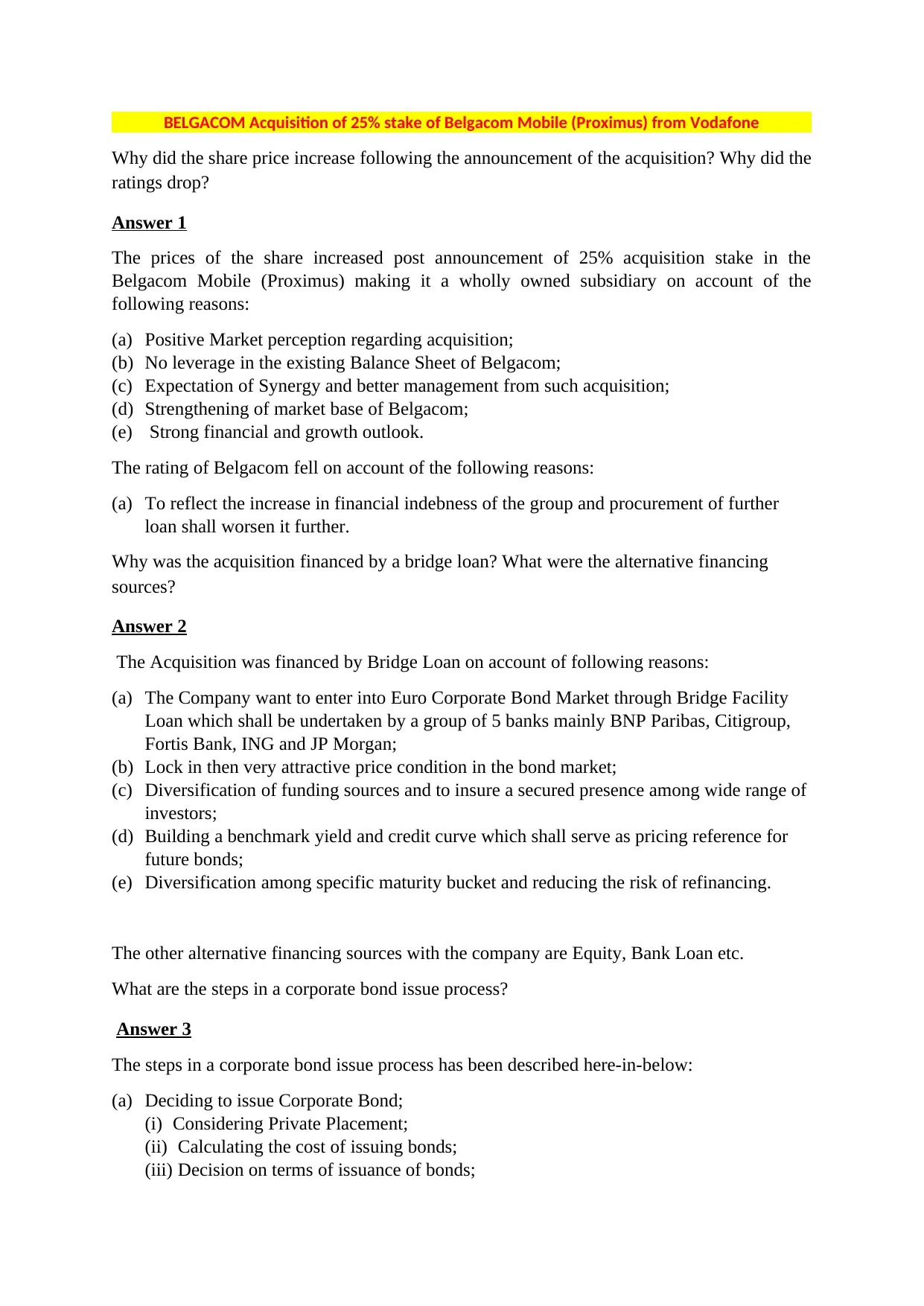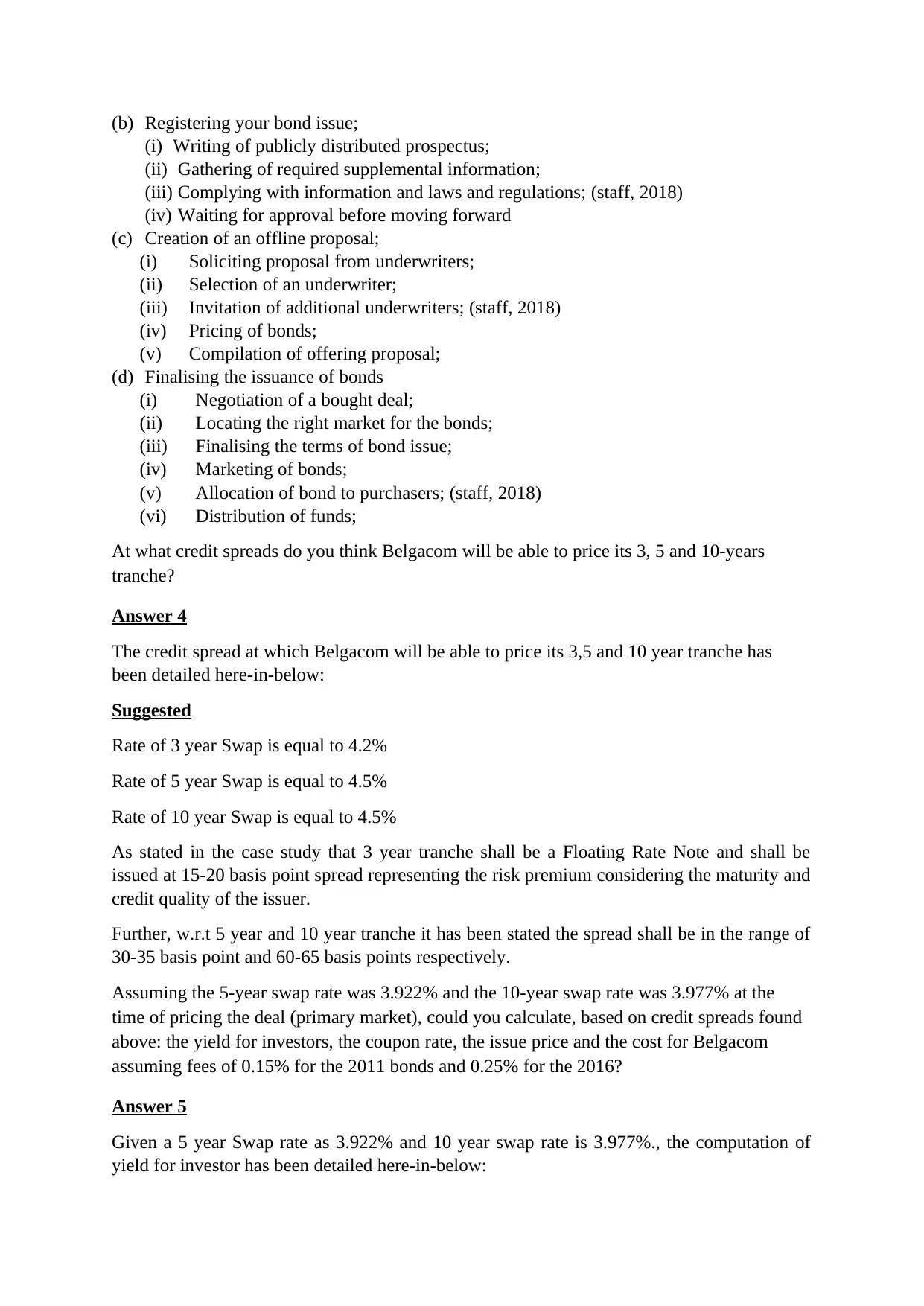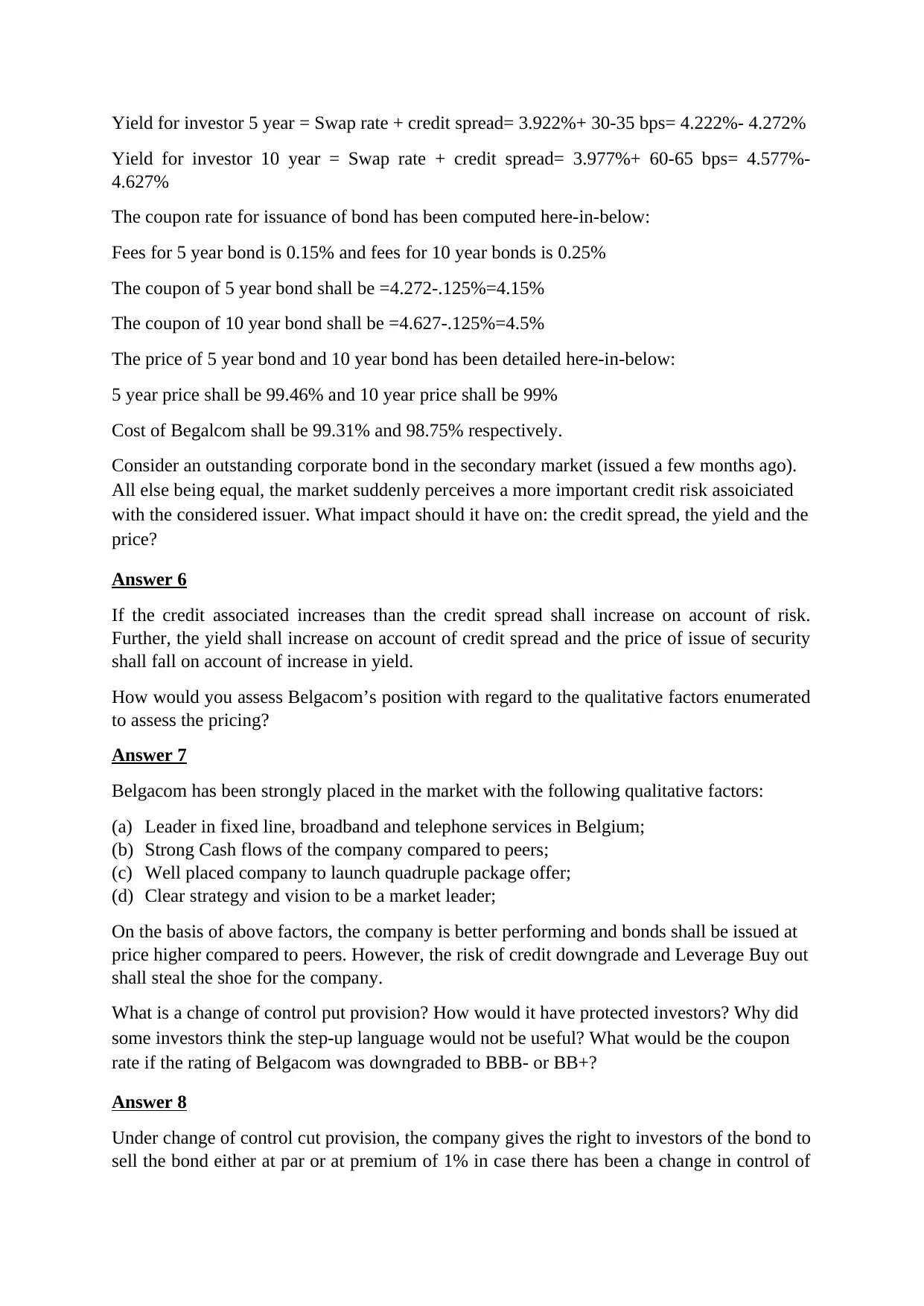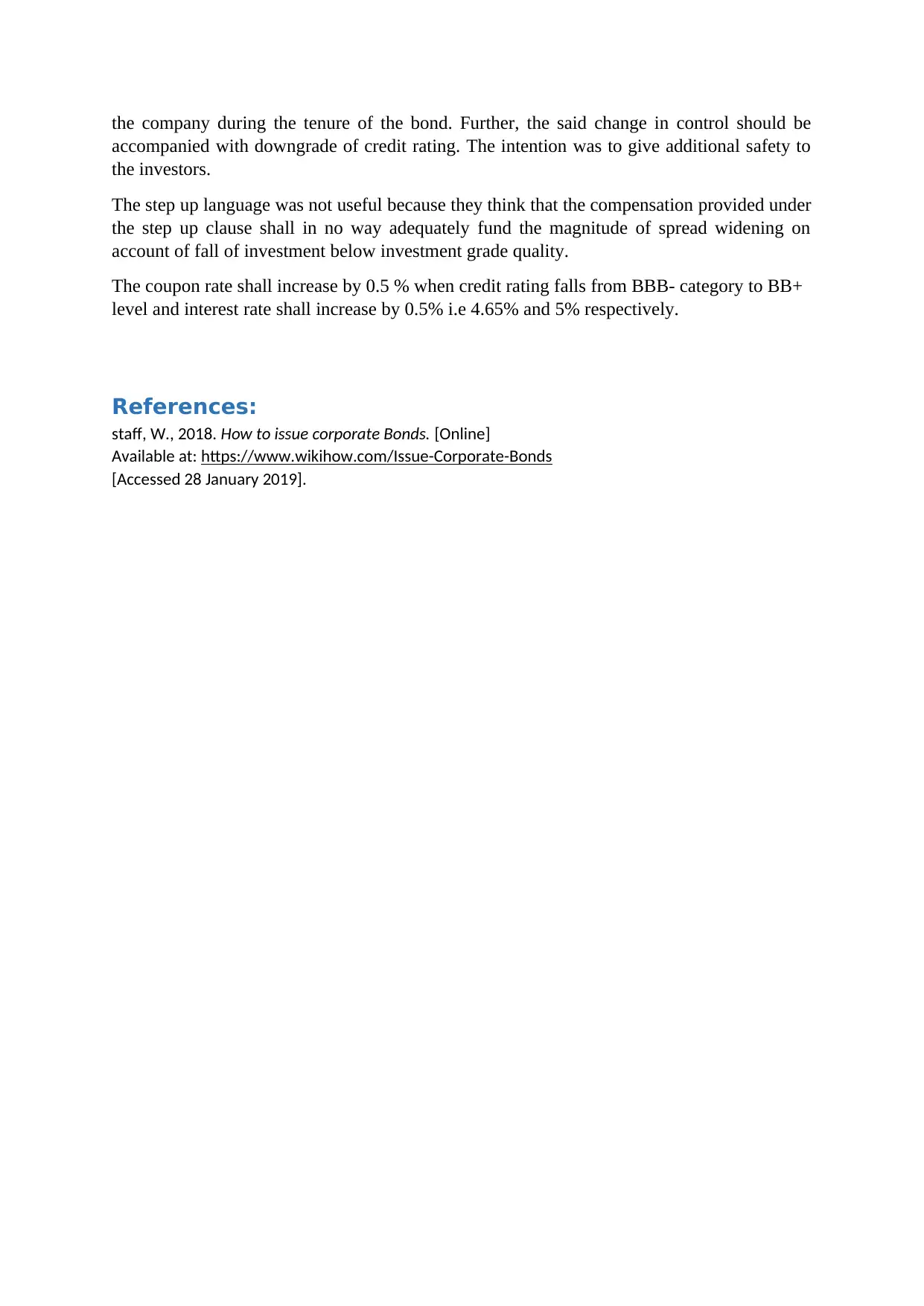Analyzing Belgacom's Acquisition, Bond Issuance and Financial Health
VerifiedAdded on 2023/04/25
|4
|1393
|253
Case Study
AI Summary
This case study delves into Belgacom's acquisition of a 25% stake in Belgacom Mobile (Proximus) from Vodafone, analyzing the subsequent increase in share price and the reasons behind the ratings drop. It explores the rationale for financing the acquisition through a bridge loan, alternative financing sources, and the steps involved in a corporate bond issuance process. The analysis includes determining appropriate credit spreads for 3, 5, and 10-year tranches, calculating yield for investors, coupon rates, issue prices, and costs for Belgacom based on given swap rates and fees. Furthermore, it assesses the impact of perceived credit risk on credit spread, yield, and price in the secondary market and evaluates Belgacom’s position based on qualitative factors relevant to pricing. Finally, the study explains change of control put provisions, their protective function for investors, and the potential ineffectiveness of step-up language, concluding with an examination of coupon rate adjustments in response to credit rating downgrades.

BELGACOM Acquisition of 25% stake of Belgacom Mobile (Proximus) from Vodafone
Why did the share price increase following the announcement of the acquisition? Why did the
ratings drop?
Answer 1
The prices of the share increased post announcement of 25% acquisition stake in the
Belgacom Mobile (Proximus) making it a wholly owned subsidiary on account of the
following reasons:
(a) Positive Market perception regarding acquisition;
(b) No leverage in the existing Balance Sheet of Belgacom;
(c) Expectation of Synergy and better management from such acquisition;
(d) Strengthening of market base of Belgacom;
(e) Strong financial and growth outlook.
The rating of Belgacom fell on account of the following reasons:
(a) To reflect the increase in financial indebness of the group and procurement of further
loan shall worsen it further.
Why was the acquisition financed by a bridge loan? What were the alternative financing
sources?
Answer 2
The Acquisition was financed by Bridge Loan on account of following reasons:
(a) The Company want to enter into Euro Corporate Bond Market through Bridge Facility
Loan which shall be undertaken by a group of 5 banks mainly BNP Paribas, Citigroup,
Fortis Bank, ING and JP Morgan;
(b) Lock in then very attractive price condition in the bond market;
(c) Diversification of funding sources and to insure a secured presence among wide range of
investors;
(d) Building a benchmark yield and credit curve which shall serve as pricing reference for
future bonds;
(e) Diversification among specific maturity bucket and reducing the risk of refinancing.
The other alternative financing sources with the company are Equity, Bank Loan etc.
What are the steps in a corporate bond issue process?
Answer 3
The steps in a corporate bond issue process has been described here-in-below:
(a) Deciding to issue Corporate Bond;
(i) Considering Private Placement;
(ii) Calculating the cost of issuing bonds;
(iii) Decision on terms of issuance of bonds;
Why did the share price increase following the announcement of the acquisition? Why did the
ratings drop?
Answer 1
The prices of the share increased post announcement of 25% acquisition stake in the
Belgacom Mobile (Proximus) making it a wholly owned subsidiary on account of the
following reasons:
(a) Positive Market perception regarding acquisition;
(b) No leverage in the existing Balance Sheet of Belgacom;
(c) Expectation of Synergy and better management from such acquisition;
(d) Strengthening of market base of Belgacom;
(e) Strong financial and growth outlook.
The rating of Belgacom fell on account of the following reasons:
(a) To reflect the increase in financial indebness of the group and procurement of further
loan shall worsen it further.
Why was the acquisition financed by a bridge loan? What were the alternative financing
sources?
Answer 2
The Acquisition was financed by Bridge Loan on account of following reasons:
(a) The Company want to enter into Euro Corporate Bond Market through Bridge Facility
Loan which shall be undertaken by a group of 5 banks mainly BNP Paribas, Citigroup,
Fortis Bank, ING and JP Morgan;
(b) Lock in then very attractive price condition in the bond market;
(c) Diversification of funding sources and to insure a secured presence among wide range of
investors;
(d) Building a benchmark yield and credit curve which shall serve as pricing reference for
future bonds;
(e) Diversification among specific maturity bucket and reducing the risk of refinancing.
The other alternative financing sources with the company are Equity, Bank Loan etc.
What are the steps in a corporate bond issue process?
Answer 3
The steps in a corporate bond issue process has been described here-in-below:
(a) Deciding to issue Corporate Bond;
(i) Considering Private Placement;
(ii) Calculating the cost of issuing bonds;
(iii) Decision on terms of issuance of bonds;
Paraphrase This Document
Need a fresh take? Get an instant paraphrase of this document with our AI Paraphraser

(b) Registering your bond issue;
(i) Writing of publicly distributed prospectus;
(ii) Gathering of required supplemental information;
(iii) Complying with information and laws and regulations; (staff, 2018)
(iv) Waiting for approval before moving forward
(c) Creation of an offline proposal;
(i) Soliciting proposal from underwriters;
(ii) Selection of an underwriter;
(iii) Invitation of additional underwriters; (staff, 2018)
(iv) Pricing of bonds;
(v) Compilation of offering proposal;
(d) Finalising the issuance of bonds
(i) Negotiation of a bought deal;
(ii) Locating the right market for the bonds;
(iii) Finalising the terms of bond issue;
(iv) Marketing of bonds;
(v) Allocation of bond to purchasers; (staff, 2018)
(vi) Distribution of funds;
At what credit spreads do you think Belgacom will be able to price its 3, 5 and 10-years
tranche?
Answer 4
The credit spread at which Belgacom will be able to price its 3,5 and 10 year tranche has
been detailed here-in-below:
Suggested
Rate of 3 year Swap is equal to 4.2%
Rate of 5 year Swap is equal to 4.5%
Rate of 10 year Swap is equal to 4.5%
As stated in the case study that 3 year tranche shall be a Floating Rate Note and shall be
issued at 15-20 basis point spread representing the risk premium considering the maturity and
credit quality of the issuer.
Further, w.r.t 5 year and 10 year tranche it has been stated the spread shall be in the range of
30-35 basis point and 60-65 basis points respectively.
Assuming the 5-year swap rate was 3.922% and the 10-year swap rate was 3.977% at the
time of pricing the deal (primary market), could you calculate, based on credit spreads found
above: the yield for investors, the coupon rate, the issue price and the cost for Belgacom
assuming fees of 0.15% for the 2011 bonds and 0.25% for the 2016?
Answer 5
Given a 5 year Swap rate as 3.922% and 10 year swap rate is 3.977%., the computation of
yield for investor has been detailed here-in-below:
(i) Writing of publicly distributed prospectus;
(ii) Gathering of required supplemental information;
(iii) Complying with information and laws and regulations; (staff, 2018)
(iv) Waiting for approval before moving forward
(c) Creation of an offline proposal;
(i) Soliciting proposal from underwriters;
(ii) Selection of an underwriter;
(iii) Invitation of additional underwriters; (staff, 2018)
(iv) Pricing of bonds;
(v) Compilation of offering proposal;
(d) Finalising the issuance of bonds
(i) Negotiation of a bought deal;
(ii) Locating the right market for the bonds;
(iii) Finalising the terms of bond issue;
(iv) Marketing of bonds;
(v) Allocation of bond to purchasers; (staff, 2018)
(vi) Distribution of funds;
At what credit spreads do you think Belgacom will be able to price its 3, 5 and 10-years
tranche?
Answer 4
The credit spread at which Belgacom will be able to price its 3,5 and 10 year tranche has
been detailed here-in-below:
Suggested
Rate of 3 year Swap is equal to 4.2%
Rate of 5 year Swap is equal to 4.5%
Rate of 10 year Swap is equal to 4.5%
As stated in the case study that 3 year tranche shall be a Floating Rate Note and shall be
issued at 15-20 basis point spread representing the risk premium considering the maturity and
credit quality of the issuer.
Further, w.r.t 5 year and 10 year tranche it has been stated the spread shall be in the range of
30-35 basis point and 60-65 basis points respectively.
Assuming the 5-year swap rate was 3.922% and the 10-year swap rate was 3.977% at the
time of pricing the deal (primary market), could you calculate, based on credit spreads found
above: the yield for investors, the coupon rate, the issue price and the cost for Belgacom
assuming fees of 0.15% for the 2011 bonds and 0.25% for the 2016?
Answer 5
Given a 5 year Swap rate as 3.922% and 10 year swap rate is 3.977%., the computation of
yield for investor has been detailed here-in-below:

Yield for investor 5 year = Swap rate + credit spread= 3.922%+ 30-35 bps= 4.222%- 4.272%
Yield for investor 10 year = Swap rate + credit spread= 3.977%+ 60-65 bps= 4.577%-
4.627%
The coupon rate for issuance of bond has been computed here-in-below:
Fees for 5 year bond is 0.15% and fees for 10 year bonds is 0.25%
The coupon of 5 year bond shall be =4.272-.125%=4.15%
The coupon of 10 year bond shall be =4.627-.125%=4.5%
The price of 5 year bond and 10 year bond has been detailed here-in-below:
5 year price shall be 99.46% and 10 year price shall be 99%
Cost of Begalcom shall be 99.31% and 98.75% respectively.
Consider an outstanding corporate bond in the secondary market (issued a few months ago).
All else being equal, the market suddenly perceives a more important credit risk assoiciated
with the considered issuer. What impact should it have on: the credit spread, the yield and the
price?
Answer 6
If the credit associated increases than the credit spread shall increase on account of risk.
Further, the yield shall increase on account of credit spread and the price of issue of security
shall fall on account of increase in yield.
How would you assess Belgacom’s position with regard to the qualitative factors enumerated
to assess the pricing?
Answer 7
Belgacom has been strongly placed in the market with the following qualitative factors:
(a) Leader in fixed line, broadband and telephone services in Belgium;
(b) Strong Cash flows of the company compared to peers;
(c) Well placed company to launch quadruple package offer;
(d) Clear strategy and vision to be a market leader;
On the basis of above factors, the company is better performing and bonds shall be issued at
price higher compared to peers. However, the risk of credit downgrade and Leverage Buy out
shall steal the shoe for the company.
What is a change of control put provision? How would it have protected investors? Why did
some investors think the step-up language would not be useful? What would be the coupon
rate if the rating of Belgacom was downgraded to BBB- or BB+?
Answer 8
Under change of control cut provision, the company gives the right to investors of the bond to
sell the bond either at par or at premium of 1% in case there has been a change in control of
Yield for investor 10 year = Swap rate + credit spread= 3.977%+ 60-65 bps= 4.577%-
4.627%
The coupon rate for issuance of bond has been computed here-in-below:
Fees for 5 year bond is 0.15% and fees for 10 year bonds is 0.25%
The coupon of 5 year bond shall be =4.272-.125%=4.15%
The coupon of 10 year bond shall be =4.627-.125%=4.5%
The price of 5 year bond and 10 year bond has been detailed here-in-below:
5 year price shall be 99.46% and 10 year price shall be 99%
Cost of Begalcom shall be 99.31% and 98.75% respectively.
Consider an outstanding corporate bond in the secondary market (issued a few months ago).
All else being equal, the market suddenly perceives a more important credit risk assoiciated
with the considered issuer. What impact should it have on: the credit spread, the yield and the
price?
Answer 6
If the credit associated increases than the credit spread shall increase on account of risk.
Further, the yield shall increase on account of credit spread and the price of issue of security
shall fall on account of increase in yield.
How would you assess Belgacom’s position with regard to the qualitative factors enumerated
to assess the pricing?
Answer 7
Belgacom has been strongly placed in the market with the following qualitative factors:
(a) Leader in fixed line, broadband and telephone services in Belgium;
(b) Strong Cash flows of the company compared to peers;
(c) Well placed company to launch quadruple package offer;
(d) Clear strategy and vision to be a market leader;
On the basis of above factors, the company is better performing and bonds shall be issued at
price higher compared to peers. However, the risk of credit downgrade and Leverage Buy out
shall steal the shoe for the company.
What is a change of control put provision? How would it have protected investors? Why did
some investors think the step-up language would not be useful? What would be the coupon
rate if the rating of Belgacom was downgraded to BBB- or BB+?
Answer 8
Under change of control cut provision, the company gives the right to investors of the bond to
sell the bond either at par or at premium of 1% in case there has been a change in control of
⊘ This is a preview!⊘
Do you want full access?
Subscribe today to unlock all pages.

Trusted by 1+ million students worldwide

the company during the tenure of the bond. Further, the said change in control should be
accompanied with downgrade of credit rating. The intention was to give additional safety to
the investors.
The step up language was not useful because they think that the compensation provided under
the step up clause shall in no way adequately fund the magnitude of spread widening on
account of fall of investment below investment grade quality.
The coupon rate shall increase by 0.5 % when credit rating falls from BBB- category to BB+
level and interest rate shall increase by 0.5% i.e 4.65% and 5% respectively.
References:
staff, W., 2018. How to issue corporate Bonds. [Online]
Available at: https://www.wikihow.com/Issue-Corporate-Bonds
[Accessed 28 January 2019].
accompanied with downgrade of credit rating. The intention was to give additional safety to
the investors.
The step up language was not useful because they think that the compensation provided under
the step up clause shall in no way adequately fund the magnitude of spread widening on
account of fall of investment below investment grade quality.
The coupon rate shall increase by 0.5 % when credit rating falls from BBB- category to BB+
level and interest rate shall increase by 0.5% i.e 4.65% and 5% respectively.
References:
staff, W., 2018. How to issue corporate Bonds. [Online]
Available at: https://www.wikihow.com/Issue-Corporate-Bonds
[Accessed 28 January 2019].
1 out of 4
Related Documents
Your All-in-One AI-Powered Toolkit for Academic Success.
+13062052269
info@desklib.com
Available 24*7 on WhatsApp / Email
![[object Object]](/_next/static/media/star-bottom.7253800d.svg)
Unlock your academic potential
Copyright © 2020–2025 A2Z Services. All Rights Reserved. Developed and managed by ZUCOL.





